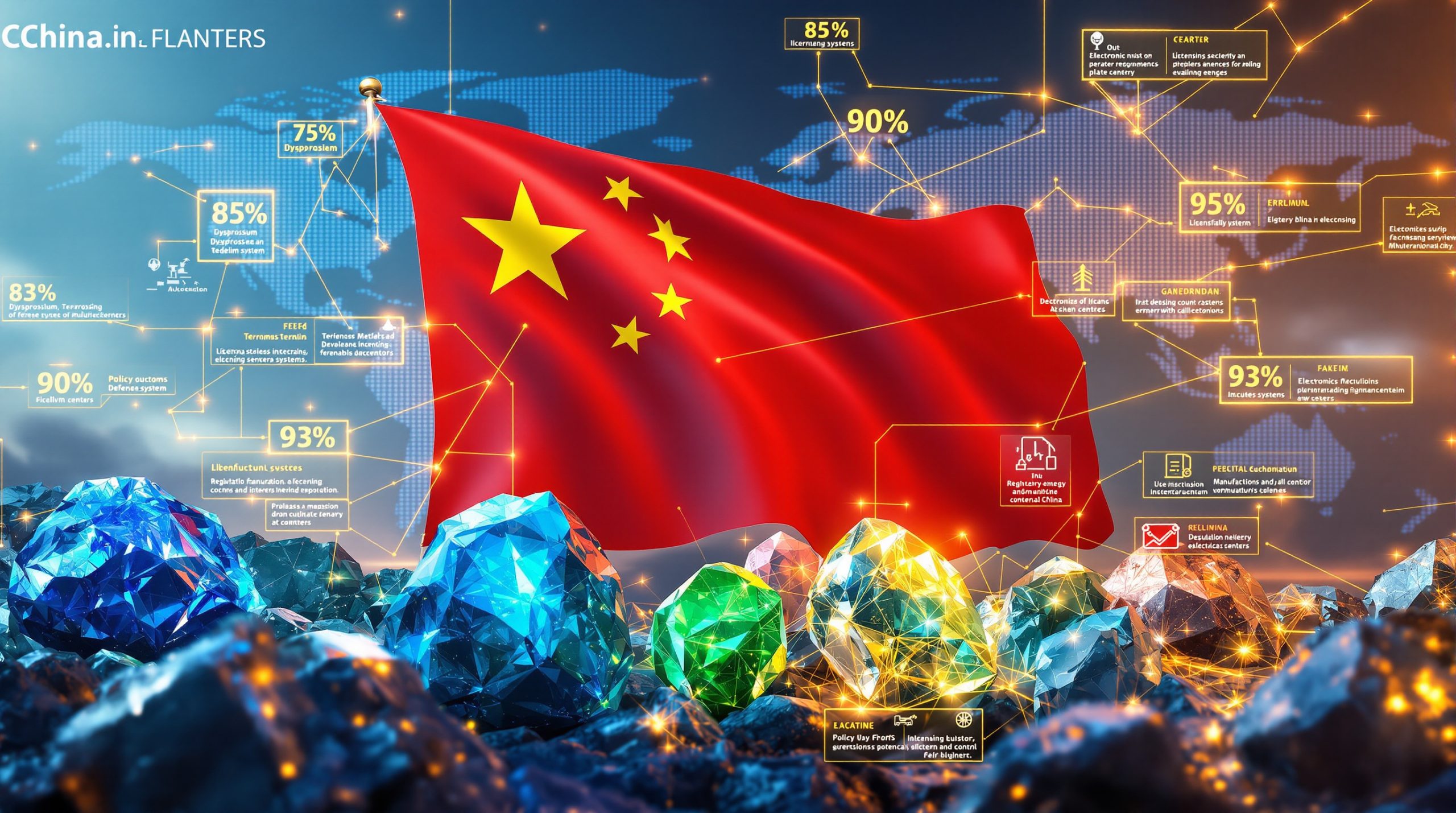What Makes China's Iron Ore Dollar Suspension a Global Game-Changer?
While global attention focused on China's rare earth export restrictions, a far more consequential economic shift occurred quietly in the commodity markets. The China iron ore US dollar suspension represents a fundamental challenge to decades of established international trade practices, with implications that extend far beyond the mining sector.
The Strategic Shift from Rare Earth Distractions to Currency Warfare
The rare earth announcement served as an effective smokescreen for China's more strategic economic manoeuvre. While policymakers and media outlets dissected the implications of restricted access to neodymium and lithium compounds, Beijing executed a calculated strike at the foundation of global trade settlement mechanisms.
China's rare earth dominance developed over decades through voluntary international arrangements. Western nations willingly outsourced the environmentally challenging and labour-intensive refinement processes required for these specialised metals. This created a supply chain dependency that, while strategically important for technology manufacturing, affects relatively narrow industrial segments.
The iron ore currency shift, however, targets the bedrock of global manufacturing. Unlike rare earth elements, which primarily impact high-tech applications, iron ore underpins steel production across virtually every industrial sector worldwide.
Understanding the $75 Billion Annual Trade at Stake
The scale of China's iron ore imports creates enormous leverage in currency negotiations. Annual trade volumes reach approximately 710 million tonnes, representing roughly $75 billion in transactions between China and major suppliers like BHP Billiton.
| Metric | Value |
|---|---|
| Annual Iron Ore Volume | 710 million tonnes |
| Trade Value | $75 billion USD |
| Yuan Settlement Percentage | 30% |
| Affected Trade Value | ~$22.5 billion annually |
When China suspended dollar-denominated purchases in September 2024, the immediate response from BHP demonstrated the practical reality of commodity market power dynamics. Within weeks, negotiations resulted in agreements for 30% yuan settlement terms, effectively shifting approximately $22.5 billion in annual trade away from dollar clearing systems.
How Did China Force BHP to Accept Yuan Payments?
The September 2024 Suspension Strategy Explained
China's approach demonstrated sophisticated understanding of supply chain vulnerabilities and corporate decision-making processes. Rather than threatening permanent trade disruption, Beijing implemented a targeted suspension strategy that created immediate pressure without triggering long-term relationship damage.
The suspension specifically targeted dollar-denominated transactions while maintaining demand for the underlying commodity. This distinction proved crucial, as it allowed Chinese importers to demonstrate state compliance while preserving essential material flows for domestic steel production.
Corporate response patterns revealed the effectiveness of this approach. BHP's management faced a clear choice: adapt payment terms or risk losing access to their largest single market. The economic mathematics overwhelmingly favoured accommodation rather than resistance.
From Dollar Dominance to 30% Yuan Settlement Terms
The negotiated settlement structure creates a hybrid payment system that gradually normalises yuan usage in international commodity trades. By implementing partial rather than complete currency substitution, China avoided triggering defensive responses from Western financial institutions while establishing operational precedents.
This incremental approach offers several strategic advantages:
• Reduced currency conversion costs for Chinese importers
• Established yuan liquidity pools within major commodity companies
• Created precedent for future bilateral negotiations
• Demonstrated practical alternatives to dollar-clearing systems
The 30% threshold represents a carefully calibrated balance between advancing de-dollarisation objectives and maintaining international business relationships. This percentage provides sufficient yuan exposure to create meaningful operational changes while avoiding the systemic disruptions that might prompt coordinated resistance.
Why Does Iron Ore Currency Matter More Than Rare Earth Restrictions?
The Manufacturing Foundation vs. Technology Components
Iron ore's role in global manufacturing creates fundamentally different economic dynamics compared to rare earth elements. While rare earths enable advanced technologies, iron ore enables basic industrial capacity across virtually every economic sector.
Steel production requires consistent, high-volume iron ore supplies that cannot easily be substituted or stockpiled for extended periods. Furthermore, this creates ongoing dependency relationships that provide continuous leverage opportunities for suppliers and importers alike.
The technical specifications for iron ore also differ significantly from rare earth requirements. Most steel production facilities can process iron ore from multiple sources with relatively minor adjustments, but they cannot operate without consistent raw material flows.
Global Steel Production Dependencies Revealed
China's position in global steel markets creates cascading effects throughout international trade networks. The country controls approximately 53% of global steel production, supplying manufactured steel products to over 150 import destinations covering more than 75% of global GDP.
The interconnected nature of steel supply chains means that disruptions in Chinese iron ore procurement directly impact manufacturing capacity across multiple continents, creating systemic vulnerabilities that extend far beyond bilateral trade relationships.
This market concentration provides China with significant influence over global construction, automotive, machinery, and infrastructure sectors. Unlike rare earth dependencies, which primarily affect specific technology applications, steel availability impacts fundamental economic activities across virtually every national economy.
What Are the Three Critical Implications of BHP's Yuan Agreement?
Precedent Setting with Western-Aligned Nations
BHP's Australian origins create particularly significant precedent value for China's currency strategy. Unlike previous yuan trade agreements with developing economies or BRICS partners, this arrangement demonstrates that major Western-aligned corporations will adapt their financial operations to accommodate Chinese currency preferences.
The precedent extends beyond commodity trading to broader questions of financial sovereignty and international monetary arrangements. BHP's agreement provides China with a template for approaching other multinational corporations and demonstrating that yuan adoption represents practical business adaptation rather than political alignment.
This development fundamentally alters negotiation dynamics for future trade discussions. China can now reference successful yuan implementation with a major G7-adjacent company when approaching other potential partners, reducing perceived risks and increasing adoption likelihood.
Creating Two-Way Currency Flow Incentives
The yuan accumulation created by iron ore sales generates natural incentives for expanded yuan usage across BHP's broader business operations. Managing large yuan positions creates operational pressure to find yuan-denominated investment and procurement opportunities.
Currency conversion costs and exchange rate risks make it economically advantageous for BHP to identify suppliers, services, and investment opportunities that accept yuan payments. This creates organic expansion of yuan usage beyond the initial iron ore transactions.
The two-way flow dynamic encourages deeper engagement with Chinese markets and yuan-denominated financial instruments. BHP now has economic incentives to:
• Expand supplier relationships with Chinese companies
• Invest in yuan-denominated securities for treasury management
• Develop yuan-based hedging strategies for currency risk management
• Explore yuan financing options for Chinese market investments
Global Economic Indifference to Dollar Displacement
The international response to BHP's yuan agreement revealed widespread indifference to dollar displacement among China's trading partners. Most economies prioritised continued access to Chinese steel products over concerns about international monetary arrangements.
This indifference reflects practical economic priorities that favour supply chain stability over abstract monetary policy considerations. For steel-importing nations, currency arrangements between China and its suppliers matter far less than reliable access to essential manufacturing inputs.
The lack of international resistance to yuan adoption demonstrates that dollar dominance depends more on practical alternatives than political preference. When yuan arrangements facilitate rather than disrupt essential trade flows, most nations remain neutral or supportive of alternative currency usage.
How Does This Accelerate Global De-Dollarisation Trends?
The Anvil and Hammer Economic Theory in Practice
The iron ore currency shift illustrates broader patterns in international economic adjustment mechanisms. When trade restrictions or currency preferences create obstacles in traditional channels, global commerce adapts by flowing around the resistance rather than stopping entirely.
China's position as a major commodity importer creates what can be understood as an economic anvil effect. However, the tariff market impact demonstrates that sanctions and trade restrictions may appear forceful and decisive, they often result in trade pattern adjustments that ultimately strengthen alternative economic systems.
The durability of China's domestic market and manufacturing capacity provides stability that allows gradual reshaping of international trade patterns. Unlike the dramatic impacts of sudden policy changes, this approach creates sustainable alternative systems that persist beyond immediate political pressures.
Historical Precedents from Russian and Iranian Sanctions
Previous sanctions regimes demonstrate how attempts to isolate major commodity producers typically result in trade redirection rather than economic isolation. Russian energy exports, following Western sanctions, found new markets primarily in Asia, with China becoming Moscow's largest energy customer.
Similarly, Iranian oil exports continue despite extensive international restrictions, with much of this trade conducted outside traditional dollar-clearing systems. These precedents suggest that sustained commodity demand creates natural pressure for alternative payment mechanisms.
Recent de-dollarisation examples include:
• Saudi Arabia: Oil sales to China settled in yuan
• France: First yuan-denominated LNG transaction completed in 2024
• Brazil-Indonesia: Bilateral yuan trading agreements established
• Russia-China: Eastern energy flow redirection with alternative currencies
The pattern reveals that sustained economic pressure tends to accelerate rather than prevent the development of alternative financial systems, particularly when major economies provide viable alternatives to dollar-based arrangements.
Which Countries Benefit Most from China's Currency Strategy?
Steel-Dependent Economies and Supply Chain Priorities
Nations with significant steel import requirements benefit from any arrangements that ensure reliable access to Chinese production capacity. These economies typically prioritise supply chain stability over international monetary arrangements, making them natural supporters of yuan adoption if it facilitates trade continuity.
Countries with substantial infrastructure development programmes show particular interest in maintaining strong relationships with Chinese steel suppliers. The scale and cost-effectiveness of Chinese steel production make alternative sources economically challenging for many developing economies.
Manufacturing-focused economies also benefit from arrangements that reduce currency conversion complexities in their supply chains. Streamlined payment mechanisms can reduce transaction costs and improve cash flow management for companies engaged in frequent trade with Chinese suppliers.
Regional Winners in the New Trading Framework
Southeast Asian economies stand to gain significantly from expanded yuan usage, given their extensive trade relationships with China and geographic proximity that facilitates economic integration. These nations often maintain currency arrangements that already accommodate yuan transactions.
Belt and Road Initiative participants may find yuan adoption particularly advantageous, as it aligns with existing Chinese investment flows and infrastructure development programmes. Currency coordination can reduce financing costs and improve project economics for these collaborative ventures.
Resource-rich nations in Africa and Latin America may benefit from diversified currency arrangements that reduce their dependence on dollar-denominated commodity pricing. Yuan alternatives can provide additional negotiating leverage and reduce exposure to dollar volatility.
What Currency Risks Does BHP Now Face?
Yuan Treasury Management Challenges
Managing substantial yuan positions creates new operational complexities for BHP's treasury operations. The company must now develop expertise in yuan-denominated financial instruments and investment options to effectively manage currency exposures.
Yuan liquidity management differs significantly from dollar operations due to regulatory restrictions and limited offshore markets. BHP must navigate Chinese capital controls while maintaining adequate yuan positions for ongoing business operations.
Consequently, the development of yuan hedging strategies requires understanding of Chinese financial markets and regulatory requirements that may be unfamiliar to traditionally Western-focused treasury teams. This learning curve creates short-term operational risks while building long-term currency management capabilities.
Exchange Rate Volatility vs. Conversion Costs
Yuan exchange rates against major currencies can exhibit different volatility patterns compared to traditional currency pairs, creating new risk management requirements for BHP's financial planning. Understanding these patterns becomes essential for accurate financial forecasting.
Conversion costs between yuan and other currencies may vary significantly depending on market conditions and regulatory changes within Chinese financial systems. These costs can impact the economic benefits of yuan adoption if not properly managed.
Disclaimer: Currency exchange rates and conversion costs are subject to market conditions, regulatory changes, and geopolitical developments that may significantly impact financial outcomes. Companies considering similar arrangements should conduct thorough risk assessments and develop appropriate hedging strategies.
How Will This Impact Australian-Chinese Trade Relations?
G7 Nation Compliance with Chinese Currency Demands
BHP's agreement demonstrates that even companies from traditional Western allies will adapt to Chinese currency preferences when economic incentives align appropriately. This precedent may influence other Australian resource companies and potentially broader bilateral trade arrangements.
The Australian government's response to BHP's yuan adoption will signal broader policy directions regarding currency diversification and economic relations with China. Supportive or neutral positions may encourage additional yuan adoption across other sectors.
In addition, future Australian resource exports to China may increasingly incorporate yuan payment options as companies observe BHP's experience and assess their own risk-benefit calculations. This could gradually shift substantial portions of bilateral trade away from dollar settlements.
Template Creation for Future Negotiations
The BHP agreement provides a practical framework that China can reference when approaching other major corporations or governments about yuan adoption. The successful implementation demonstrates feasibility and reduces perceived risks for future adopters.
Chinese negotiators now possess a concrete example of yuan integration within a major Western corporation, including operational details, risk management approaches, and business continuity measures that address common concerns about currency diversification.
This template may accelerate yuan adoption discussions across multiple industries and geographic regions as companies recognise that currency diversification can be implemented without fundamental business disruption.
What Does This Mean for US Dollar Global Dominance?
The 80-Year Dollar Standard Under Pressure
The post-World War II international monetary system established the dollar as the primary reserve and trading currency based on US economic dominance and political stability. However, the emergence of alternative economic centres creates natural pressure for currency diversification.
Dollar dominance historically provided the United States with significant economic advantages, including reduced borrowing costs, enhanced monetary policy effectiveness, and the ability to finance trade deficits through currency demand from international partners.
The gradual erosion of dollar usage in major commodity trades reduces these advantages incrementally rather than dramatically. Each successful yuan transaction demonstrates practical alternatives and reduces perceived risks of dollar diversification for other market participants.
Sanctions Weaponisation Backfire Effects
The increasing use of financial sanctions as foreign policy tools has created incentives for major economies to develop alternative payment systems that bypass dollar-clearing mechanisms. This defensive motivation accelerates de-dollarisation beyond what might occur through purely economic considerations.
Countries and corporations that face potential sanctions risks now have strong incentives to establish alternative financial relationships that provide operational continuity even if traditional dollar-based systems become unavailable. For instance, the US–China trade strategy demonstrates how economic tensions create market pressures for alternative arrangements.
The weaponisation of currency access has inadvertently created market opportunities for alternative currencies and payment systems, potentially accelerating their development and adoption beyond what would occur through normal competitive processes.
Disclaimer: Analysis of currency dominance involves complex geopolitical and economic factors that are subject to rapid change. Future developments may differ significantly from current trends and historical patterns.
Which Sectors Could See Similar Currency Shifts Next?
Energy Trade Vulnerability Analysis
Energy markets represent the most likely candidates for expanded yuan adoption due to China's position as the world's largest energy importer and the strategic importance of energy security for national economies. Chinese energy companies already conduct substantial trade in yuan with certain suppliers.
Natural gas imports to China may increasingly incorporate yuan settlements, particularly for pipeline gas from Russia and Central Asian suppliers where dollar alternatives provide mutual benefits for both buyers and sellers.
Renewable energy equipment trade represents another potential area for yuan expansion, given China's dominant position in solar panel, wind turbine, and battery manufacturing. Countries purchasing these technologies may find yuan arrangements economically advantageous.
Agricultural and Manufacturing Supply Chains at Risk
Chinese agricultural imports, particularly soybeans, corn, and other bulk commodities, represent significant trade volumes that could potentially shift toward yuan settlements. Major agricultural exporters may find yuan arrangements attractive for accessing Chinese markets.
Manufacturing supply chains involving Chinese production or assembly may naturally evolve toward yuan usage as companies seek to reduce currency conversion complexities and improve cash flow management across their operations.
Textile, electronics, and consumer goods sectors may experience gradual yuan adoption as Chinese manufacturers offer preferential terms for yuan-denominated transactions, particularly for high-volume or long-term supply arrangements.
What Does This Mean for Iron Ore Market Dynamics?
Price Discovery and Settlement Mechanisms
The shift away from dollar-denominated settlements affects fundamental price discovery mechanisms in global iron ore markets. When substantial volumes trade in yuan, price benchmarks may gradually reflect multiple currency influences rather than purely dollar-based valuations.
This currency diversification in settlement could potentially reduce price volatility related to dollar strength fluctuations. However, iron ore trends indicate that market fundamentals remain the primary driver of pricing dynamics regardless of settlement currency.
The emergence of yuan-settled iron ore contracts may create arbitrage opportunities between different currency markets, potentially increasing market complexity while providing additional hedging mechanisms for industry participants.
Supply Chain Adaptation Requirements
Mining companies globally now face pressure to develop yuan-handling capabilities to maintain competitiveness in Chinese markets. This includes establishing appropriate treasury management systems and currency risk management protocols for yuan exposure.
The adaptation requirements extend beyond immediate suppliers to include shipping, insurance, and financing companies that support iron ore trade flows. This creates systemic changes throughout the supply chain ecosystem.
Furthermore, the gradual normalisation of yuan usage in commodity trades may accelerate similar currency diversification across other mining sectors, as companies develop operational expertise and infrastructure for alternative currency management.
How Are Other Commodity Markets Responding?
Cross-Sector Currency Adoption Patterns
The success of yuan adoption in iron ore markets creates demonstration effects across other commodity sectors. Mining companies with diversified portfolios may find operational advantages in standardising yuan capabilities across multiple product lines.
Agricultural commodity traders are closely monitoring the iron ore precedent as they evaluate currency diversification opportunities in their own Chinese trade relationships. The operational frameworks developed for iron ore may prove adaptable to other bulk commodity trades.
Energy sector participants, particularly those involved in Chinese LNG and crude oil imports, are assessing whether similar yuan adoption strategies could provide competitive advantages or operational efficiencies in their market segments.
Regional Market Integration Effects
Asian commodity markets show increasing integration with yuan-denominated trading systems as regional economies adapt to China's currency preferences. This creates natural trading zones where yuan usage becomes increasingly standardised.
The China's iron ore surplus situation demonstrates how supply-demand dynamics interact with currency policy to influence broader market structures and regional trading patterns.
European and American commodity markets remain primarily dollar-focused, but increasing Chinese demand and yuan adoption create pressure for currency flexibility to maintain market access and competitiveness.
How Should Investors Position for Continued De-Dollarisation?
Currency Diversification Strategies
Investment portfolios may benefit from increased exposure to yuan-denominated assets as global trade patterns shift toward greater currency diversification. This includes direct yuan investments as well as companies positioned to benefit from yuan adoption trends.
Currency diversification should be approached gradually and with appropriate risk management, as yuan markets operate under different regulatory frameworks compared to traditional Western financial systems. Professional guidance is essential for navigating these complexities.
Understanding Chinese capital controls, investment restrictions, and regulatory requirements becomes increasingly important for investors considering yuan exposure as part of broader portfolio diversification strategies.
Commodity Exposure in Non-Dollar Markets
Commodities traded in alternative currencies may offer portfolio diversification benefits and potential protection against dollar weakness. This includes yuan-denominated commodity investments and companies engaged in non-dollar commodity trading.
Mining companies, energy producers, and agricultural businesses with significant Chinese market exposure may benefit from yuan adoption trends through reduced currency risks and improved access to Chinese markets.
Infrastructure and manufacturing companies positioned within Chinese supply chains or Belt and Road Initiative projects may experience advantages from yuan integration and reduced currency conversion complexities.
Regional Trade Bloc Investment Opportunities
Investment opportunities within regional trading arrangements that emphasise alternative currencies may provide exposure to de-dollarisation trends while diversifying geographic and currency risks across multiple markets.
Companies positioned within BRICS nations, ASEAN countries, or other regional trading arrangements may benefit from increased economic integration and reduced dependence on dollar-clearing systems.
Technology, manufacturing, and financial services companies that develop capabilities for multi-currency operations may be well-positioned to capitalise on increasing currency diversification trends across global trade networks.
The rising iron ore demand from emerging markets creates additional investment opportunities in companies positioned to benefit from both increased commodity demand and currency diversification trends.
Disclaimer: Investment decisions should be based on thorough research, professional advice, and individual risk tolerance. Currency diversification involves significant risks including exchange rate volatility, regulatory changes, and political developments that may impact investment outcomes. Past performance does not guarantee future results.
Looking to Capitalise on Commodity Market Disruptions?
Discovery Alert's proprietary Discovery IQ model delivers real-time alerts on significant ASX mineral discoveries, transforming complex commodity market shifts into actionable investment opportunities for savvy traders and long-term investors alike. With major structural changes reshaping global trade patterns, positioning yourself ahead of market-moving discoveries becomes crucial for maintaining your competitive edge—begin your 30-day free trial today and turn market volatility into profit potential.




